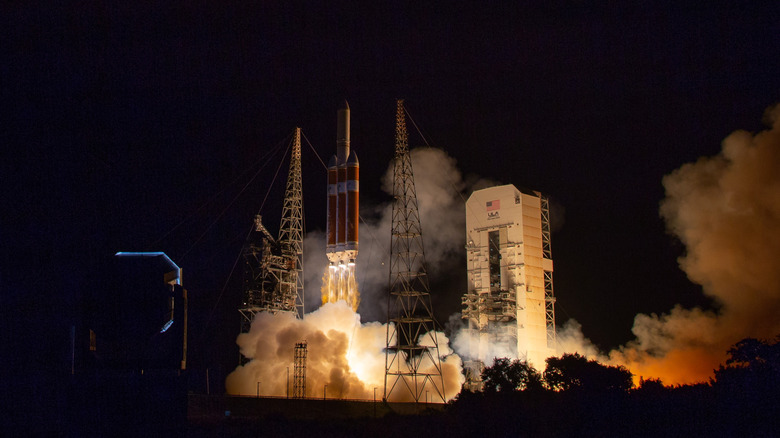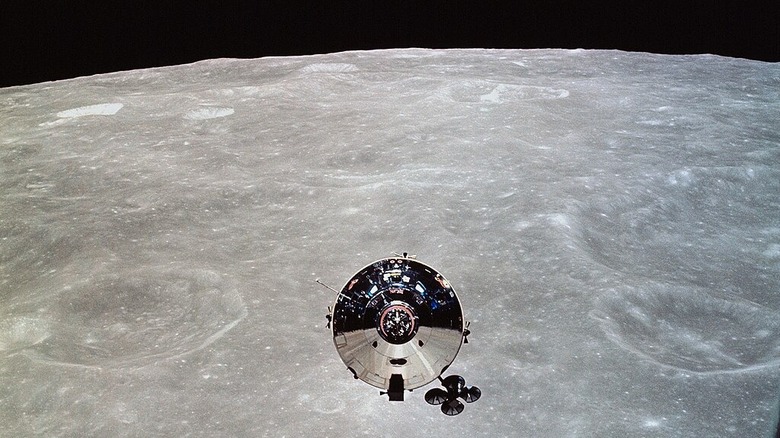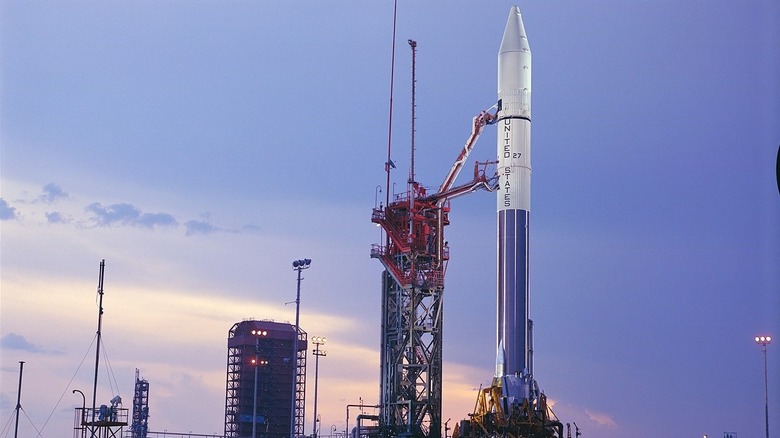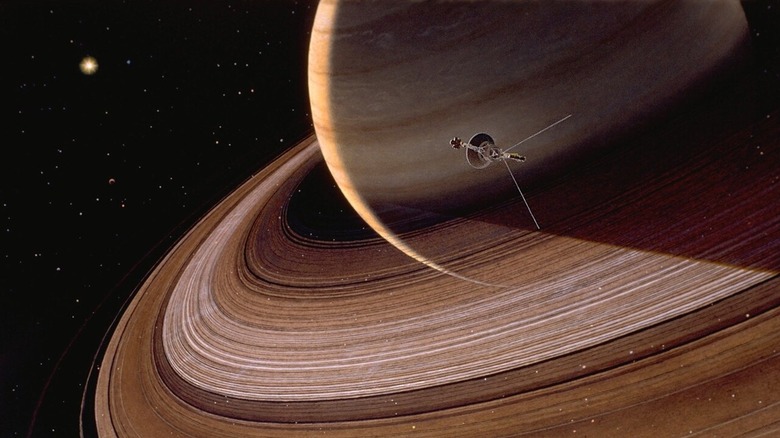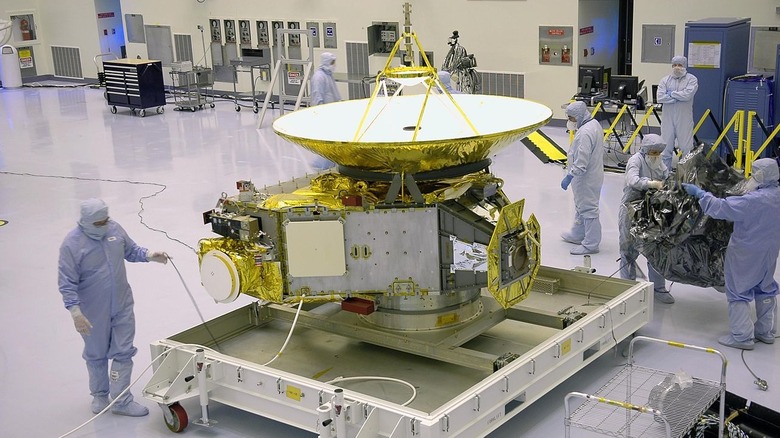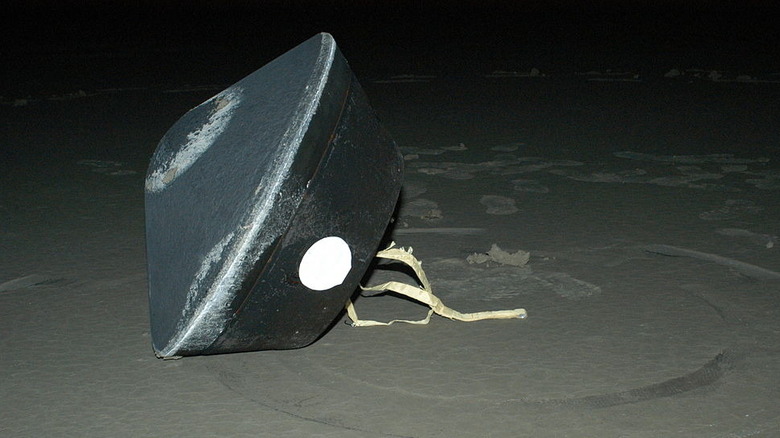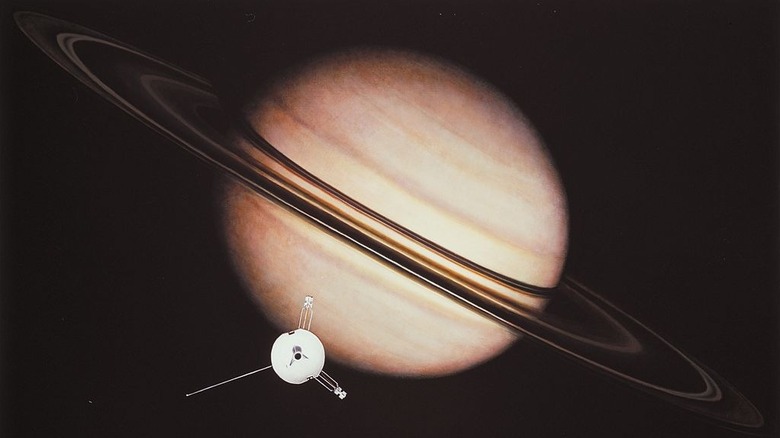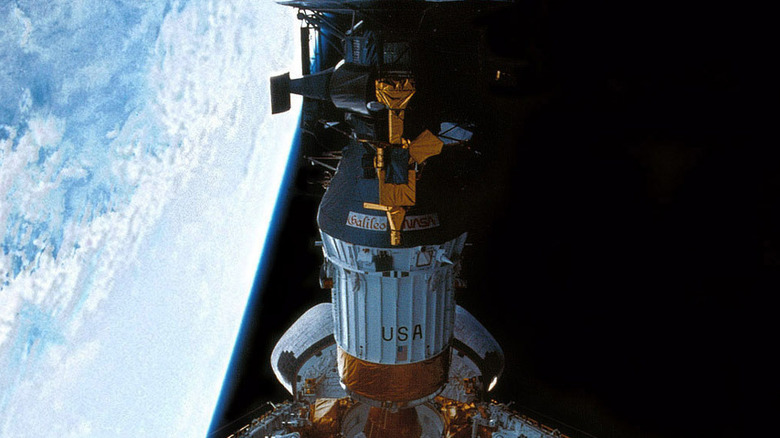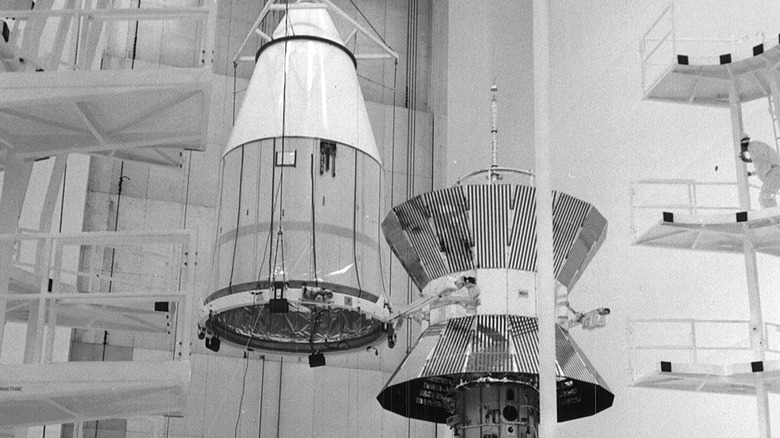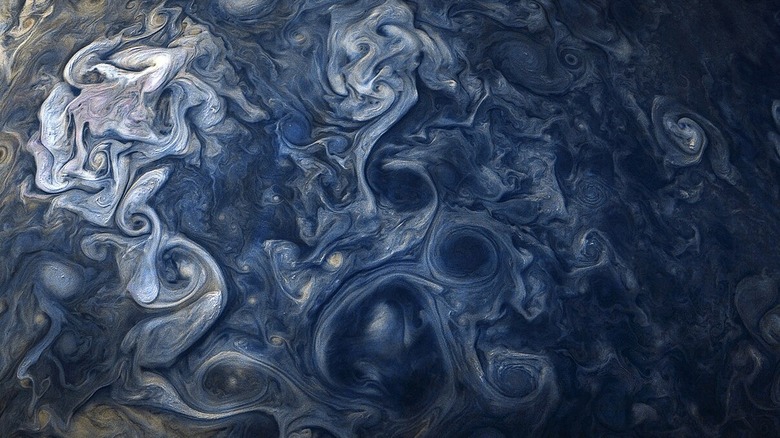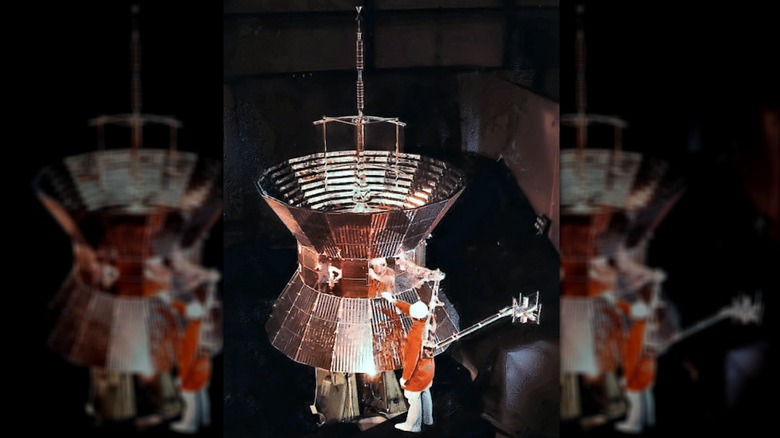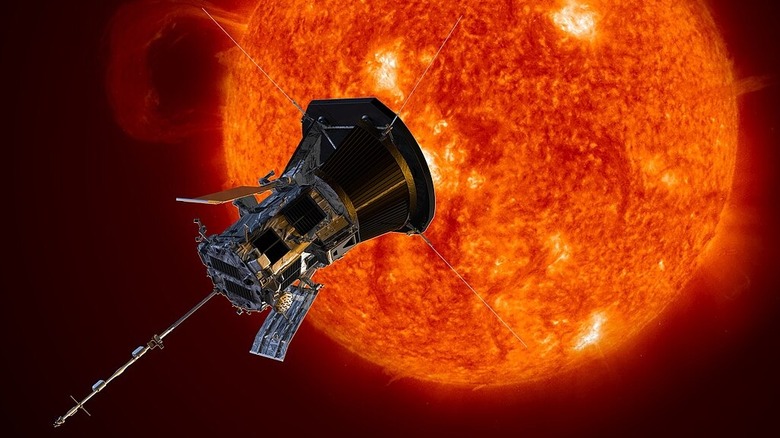13 Of The Fastest Human-Made Objects To Ever Enter Space
In the pursuit of space exploration, humans have broken records that were previously thought impossible. At the same time, terrible accidents have marred the history of space flight, making later achievements even more poignant. One impressive feat of space travel is humans' ability to build spacecraft that can sustain high speeds, not only during launch, but while traveling throughout the solar system. While spacecraft like the International Space Station are fascinating — traveling at around 17,500 mph — plenty of faster human-made objects are out in space right now.
But what, exactly, constitutes space, and how fast is fast? It turns out that even the highest-flying military jets don't actually reach space. Actual space is about 50 to 62 miles above Earth's surface, depending on which scientists you ask. That means satellites can be included on the list of human-made objects in space, but they're not quite fast enough to make the list of the fastest ever spacecraft. Even Starlink satellites, which routinely travel around 17,000 mph (and you can spot them from the ground), can't beat the fastest human-made objects to enter space. For reference, the land speed record is 763.035 mph and a bullet can travel at up to 2,727 mph. The speed of sound, Mach 1, is 761.2 mph, making these spacecraft and other objects excessively fast, to a point humans can only begin to comprehend.
Apollo 10 Command Module
The only humans on Earth who can begin to comprehend the speeds of the fastest human-made objects in space might be the crew of Apollo 10. Apollo 10's crew was the first to complete a test lunar landing, just without actually landing. The spacecraft's mission was to orbit the moon, dock with a module, and transmit data back to crews on Earth, including TV footage.
Three crew members — Thomas Stafford, Eugene Cernan, and John Young — successfully completed the mission and made a record in the process. Upon its return to Earth on May 26, 1969, the Apollo 10 Command Module set the record for the fastest speed of a crewed vehicle. It reached 24,791 mph when returning from outer space, which remains the fastest speed humans have ever traveled. Cernan, the Lunar Module Pilot, described looking out the window during re-entry as being inside a ball of flames. Apollo 10 was the first crewed lunar mission to rehearse a full landing, making it noteworthy in multiple ways, speed being just one of them. Further, none of the other fastest human-made objects to enter space carried people aboard, which might be a good thing.
Pioneer 10
While Apollo 10 broke records with its over 24,000 mph re-entry, plenty of other human-made crafts have exceeded that speed in the years since. Pioneer 10 set new milestones after Apollo 10 and was also noteworthy in terms of space exploration progress, especially when its mission began in 1972. Pioneer 10 was the first NASA mission to explore the outer planets, and though the plan was to send it out for less than two years, it wound up spending over 30 years in space. It aimed to leave the solar system and venture into interstellar space, which it successfully did, passing by Jupiter, Saturn, and Neptune. It was also the first robotic spacecraft to travel through the asteroid belt and beyond Jupiter.
All of this was achieved using nuclear electric power, which produced around 140 watts while Pioneer 10 explored around Jupiter. Among its many milestones, Pioneer 10 traveled at around 32,110 mph escape velocity, breaking the speed record of its time. Today, Pioneer 10 is still somewhere in space, far beyond the 7.6 billion miles it had reached when it sent its last signal to Earth in 2003.
Voyager 2
In the 1970s, NASA launched the Voyager probes, both of which have now entered interstellar space and will never return to Earth. When they were launched, both spacecraft were probably moving slower, but today, both travel in excess of 30,000 mph. For reference, 30,000 mph is about 39 times the speed of sound, or about Mach 39 in Earth's atmosphere, though Mach numbers don't technically apply in space. According to NASA, Voyager 2 is the only human-made object to have visited Uranus and Neptune. It even discovered a 14th moon on Jupiter, and 10 new moons (and two more rings) on Uranus. Today, Voyager 2 has concluded its studies and travels at around 35,000 mph, moving away from Earth.
Yet during some parts of the year, Earth's orbit makes the planet follow the Voyager spacecraft; for a few months out of each year, we're closer to the Voyager craft than the rest of the year. That's because Earth moves faster than the spacecraft. Want to really blow your mind? Earth is moving 67,100 mph in its orbit around the Sun, which makes it very easy for the planet to catch up to the Voyager probes during its elliptical orbit.
New Horizons
New Horizons launched in 2006 on a mission to explore Pluto, but that wasn't the only goal. Another target was the Kuiper Belt and, specifically, an object called Arrokoth. NASA says Arrokoth is the most distant object that a human-made craft has explored up close. Along the way, New Horizons also took photos of Jupiter's moons during its travels.
New Horizons may not be as fast as some more modern spacecraft, but it had the highest launch speed. NASA called it the "highest launch velocity attained by a human-made object relative to Earth." The craft reached 36,400 mph before its journey even really began. Later, NASA reported that New Horizons passed by Jupiter for a gravity assist, which sped it up to about 45,400 mph. Despite its velocity, it was able to snap photographs of Pluto and its moons, and ultimately determine Pluto's actual size (about 1,470 miles in diameter). Since its launch, New Horizons has traveled about 300 million miles each year. It has completed multiple missions, and researchers have occasionally placed the spacecraft into hibernation mode as it continues through the solar system.
Voyager 1
Although both Voyager craft move pretty fast, Voyager 1 is slightly (well, on the massive velocity scale we're looking at here) faster. It was sent to space to explore Jupiter and Saturn way back in 1977, and while it shares the same design as Voyager 2, it was launched later. It also left the asteroid belt before Voyager 2. Voyager 1 travels at around 38,210 mph, again moving away from Earth, never to return. It entered interstellar space in 2012 (Voyager 2 followed in 2018), and its current mission is to explore the edge of the solar system and beyond.
In addition to its far-flung adventures and impressive speed, Voyager 1 is also known for a photo it took in 1990. The image shows Earth from such a distance that it appears as a small dot in a sunbeam — the now-iconic "Pale Blue Dot." Voyager 1 took the photo on February 14, 1990, when it was 3.7 billion miles away from the Sun. As it continued to speed away, it captured other photographs of our solar system as well.
Stardust Capsule
Unlike many other high-speed spacecraft, Stardust was built to return to Earth after its impressive space flight. It might not look high-tech, but the Stardust Capsule had an important task to complete, so it only had to be functional, not pretty. Its job was to collect material from outside Earth's orbit, specifically from one comet. It was also tasked with retrieving interstellar dust and used a specialized sponge-like material to collect "cometary and interstellar dust samples."
Stardust launched in 1999 and returned to Earth in 2006. When it re-entered Earth's atmosphere, it was going about 29,000 mph, breaking the record for re-entry speed by a human-made object. But that wasn't its top velocity; Stardust traveled at an average speed of around 48,000 mph while cruising through space, covering nearly 3 billion miles during its mission. Like most equipment designed to return to Earth, it had a heat shield and parachute and landed uneventfully in the Utah desert. Today, the Stardust capsule is on display at the National Air and Space Museum in Washington, D.C.
Pioneer 11
If you thought Pioneer 10's escape velocity of 32,110 mph was impressive, wait until you hear about Pioneer 11. Pioneer 11 was launched to study Saturn and departed in 1973. The 570-pound spacecraft completed its flyby mission past Jupiter in 1974, and in 1979, it reached Saturn. Pioneer 11 reached a relative velocity of 71,000 mph as it passed by Saturn, making it one of the fastest human-made objects to ever enter space.
During its travels, Pioneer 11 sent countless images back to researchers on Earth, including around 200 images of Jupiter's moons. It also took hundreds of photos of the planetary system of Saturn, and reported data like the temperature of the moon Titan; it was minus 315 degrees Fahrenheit during the flyby. Later, Pioneer 11 passed by Neptune, the fourth to accomplish this feat, after Pioneer 10, Voyager 1, and Voyager 2. Despite a launch in the early 1970s, Pioneer 11's story didn't end until 1995, when scientists received the last message (containing engineering data) from the spacecraft. In 2017, scientists estimated that Pioneer 11 was about 9.1 billion miles away from its home planet — no word on how fast it's traveling now, though.
Galileo
Galileo was a spacecraft sent to explore Jupiter back in 1989, and its mission was ultimately successful, despite ending in a crash. Galileo wasn't launched on its own from Earth; it rode along in the cargo bay of Atlantis, a space shuttle. From the moment it was deployed into orbit, Galileo completed a host of firsts: It performed the first flyby of an asteroid (and caught images), directly observed a comet hitting a planet's atmosphere, and became the first human-made spacecraft to orbit an outer planet.
Speed-wise, Galileo was massively impressive, and one of its probes traveled at 106,000 mph while exploring Jupiter's atmosphere. Over the course of its mission, Galileo traveled more than 2.8 billion miles, completing dozens of flybys of Jupiter's moons during three mission extensions. In the end, researchers intentionally crashed Galileo into Jupiter's atmosphere at a speed of about 108,000 mph to avoid a potential collision with the moon Europa, since the spacecraft was running out of propellant. Clearly, the Galileo mission was epic, but so was the team behind it. It turns out, nuclear engineer Lonnie Johnson developed the Super Soaker (and later got rich) while working on the mission.
Helios 1 Probe
In 1974, scientists sent a $260 million probe into space to study the Sun and solar processes. Helios 1 was a collaboration between American and German scientists to study deep space, and it was wildly successful. The futuristic probe was designed with plasma, cosmic ray, electron, and light sensors to capture as much information as possible. Helios 1 got closer to the Sun than any other human-made object at the time, within about 29 million miles. At that point, it was traveling at speeds of 148,000 mph, blasting prior human-made objects out of the water (or atmosphere?) in terms of velocity. Surface mirrors helped protect Helios 1's equipment as it passed relatively close to the Sun, while sensors collected data about the environment.
Helios 1 found, for one thing, that there are 15 times more micrometeorites around the Sun than around Earth. NASA reports that the last data was received from Helios 1 in 1982, while it also states that the last contact was in 1986. The probe sustained damage due to experiencing temperatures of around 270 degrees Fahrenheit during its solar travels, which is thought to have contributed to its receivers failing. Still, Helios 1 is thought to remain in orbit today.
Juno Spacecraft
Another super-fast human-made object in space, the Juno spacecraft can reach speeds of 165,000 mph, according to NASA. Juno is a space probe launched in 2011 with the mission of exploring the Jovian system. Named after the Roman god Jupiter's wife, Juno's job is to observe Jupiter and report back to Earth. Juno completed its first mission in 2021, using onboard instruments like a magnetometer, radio and plasma wave sensor, ultraviolet spectrograph, and a specialized camera/telescope to investigate Jupiter. While Juno's regular speed is listed at 150,000 mph, that was its arrival speed as it greeted Jupiter's gravitational pull. It had to slow down to enter Jupiter's orbit, where researchers aimed for it to travel about 1.8 billion miles.
Juno's looping orbit involves pulling away from the planet and then being pulled back in by gravity, and most of its journey is automated, according to NASA. Relaying orders to Juno takes 48 minutes, with a reply taking just as long to arrive. Though Juno has completed multiple missions, it's still active and set to complete additional tasks, with the current mission winding down in 2025.
Operation Plumbbob Pascal B Cap
As far as spacecraft go, it's highly impressive that a human-made craft can travel in excess of 100,000 mph out in space. But it's not only spacecraft that can allegedly reach such speeds — according to one urban legend that may just be true. NASA's Jet Propulsion Laboratory maintains that the story of a manhole cover being accidentally launched into space is an urban legend. Still, it lists the Pascal B Cap as one of the fastest human-made objects to ever enter space, clocking over 100,000 mph. Other sources suggest that the Pascal B Cap traveled at as much as 150,300 mph, based on a photo taken by a camera placed near the cap (and the camera's frames per second speed).
During Operation Plumbbob, a 1957 nuclear testing project, it's said that one of the 29 underground tests detonated with such force that it blew a manhole cover, the Pascal B Cap, into space. The cap is thought to have traveled at more than six times Earth's escape velocity. Unlike spacecraft designed for space travel, the manhole cover had no equipment and no way to slow down. It's still debated whether it reached space or burned up in the atmosphere, but its launch remains one of the most bizarre and possibly record-breaking events in human-made velocity.
Helios 2 Probe
Helios 2 got even closer to the Sun than Helios 1 and at faster speeds. While Helios 1 launched in 1974, Helios 2's launch in 1976 resulted in an even closer flyby of the Sun. Traveling as close as 27 million miles away from the Sun, Helios 2 broke Helios 1's record, but the success was somewhat short-lived. Following some equipment failures in 1980, researchers knew Helios 2 was nearing the end of its useful life. By 1981, Helios 2 was shut down. The idea was that shutting down the spacecraft would help avoid any radio interference with later missions.
Much faster than other comparable probes, Helios 2's record is said to be 207,408 mph, or 92,720 meters per second. It makes sense when you consider gravity; the gravitational pull is stronger the closer a craft gets to the Sun. Thus, the orbital speed has to be faster in order for the spacecraft to maintain its chosen course. Though it's now old technology, the Helios 2 Probe accomplished feats that were only beaten in much more modern times. In fact, one particular solar probe was only able to beat Helios 2's record in 2018.
Parker Solar Probe
Given the physics of lightspeed travel, the Parker probe almost sounds like science fiction. Although it doesn't come close to the speed of light, the solar probe is so fast, it beats out every other human-made object to ever enter space. After its launch, the Parker Solar Probe traveled through the Sun's atmosphere at speeds of around 430,000 mph. That's faster than any human-made object has ever traveled, let alone in space.
The Parker Solar Probe is one of the most important satellite launches in history, breaking multiple records, including its ability to travel closer to the Sun than any previous spacecraft. It became the only spacecraft to beat Helios 2's record in 2018, getting within 15 million miles of the Sun. Even more impressively, it came within 3.8 million miles in 2024. While that might still sound far, the spacecraft had to withstand temperatures of nearly 2,500 degrees Fahrenheit at that distance. To date, the Parker probe has traveled through the Sun's upper atmosphere (the corona), which technically means humans have created an object that can touch the Sun.
